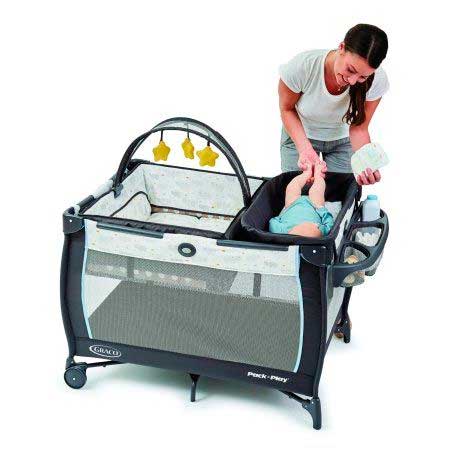Pack and plays, those universal pieces of baby gear, have become a staple in many households. The main reason for this is that pack and plays offer a secure space for your children to rest, play, have fun, and explore new things.
Honestly, it is the best solution for your kids. As parents, we often find ourselves pondering how long our babies can safely slumber in these portable cribs.
Of course, every kid grows as time flies. And then they are going to feel extremely uncomfortable in such a crib. So, here you can get an explanation of the depths of pack and plays, investigating their longevity, safety guidelines, and the telltale signs that your baby may have outgrown this trusty piece of equipment.
The Versatility of Pack and Plays

Pack and plays are a cherished addition to baby registries for a multitude of reasons. They serve as a safe haven for infants and toddlers alike, accommodating children from birth to around 2 to 3 years old.
These portable wonders deliver convenience and protection akin to a crib, allowing parents the flexibility to move them around the house for naps, rest, or playtime.
How long can a baby sleep in a pack n play?
The burning question for many mothers and fathers is how long their baby can sleep in a pack-and-play. In general, most babies can comfortably slumber in a pack and play until they reach the age of two to three years. Nonetheless, there are specific criteria to consider. Let's take a look at them.
Pack and Play Age Limits

Typically, pack and play age limits are officially set at three years old, but many children outgrow them sooner due to height, weight, developmental milestones, or other reasons.
Some brands, like the Bugaboo Stardust, even have a younger age limit, capping at two years old. So, the age of your child really matters.
Height Aspect
In the United States, pack and plays adhere to strict regulations set by the Consumer Product Safety Commission, designed for children less than 35 inches tall.
However, it is worth noting that distinct manufacturers may have varying height limits. This is why consulting your user manual is prudent, especially as your child approaches thirty-five inches.
Weight Limits

Most pack and plays have a weight limit of 30 pounds, though there are exceptions. Interestingly, certain play yards forgo weight limits for the main playpen part and utilize floor-sitting mattresses.
Examples include the Lotus Pack and Play, the Babybjorn pack and play, and the Phil and Teds Traveller. If your child nears 25 to 30 pounds and continues to use a pack and play, please consult your user manual for verification.
Ensure that your child is not too heavy for using a pack and play. Apart from that, there are other signs that you might need to change from a crib to something else.
Milestones Indicating that Your Baby Has Outgrown Their Pack and Play
Determining when your baby has outgrown their pack and play goes beyond mere age, height, and weight. It also hinges on developmental and temperamental milestones, such as these:
-
Standing in the Pack and Play
While it is generally safe for young children to stand up in the play yard, if they start pushing the edges or destabilizing the frame, it is time to move on. So, please try to notice when your child starts to act differently, especially those children who climb out of the crib. -
Attempting to Climb Out
When your child attempts to climb out of the pack and play, it becomes a safety concern. In this case, consider transitioning to a play yard with no weight limit or using alternative options like the Guava Lotus Everywhere Crib or the Phil & Teds Traveller. -
Personality and Comfort
Some children simply dislike confinement, and if your toddler consistently expresses frustration or refusal, it's a clear sign to discontinue pack and play use. -
Strength and Stability
Stronger toddlers may challenge the pack and play's structural integrity. Assess your child's ability to avoid accidents.
Safety Guidelines for Using Pack and Plays
Ensuring your baby's safety in a pack and play is paramount. Consider the following safety guidelines:
-
Inspect for Damage
Check for stretched mesh or damaged fabric as these can pose hazards. The original mattress should be in good condition. -
Proper Fitting Sheets
Use tight-fitting pack and play sheets to prevent loose fabric and ensure your baby's safety. -
Missing Parts
If your pack and play is missing parts or hardware, refrain from using it until you can obtain and install replacement components. -
Safe Play Area
Ensure a flat, hazard-free surface for the pack and play. Avoid areas with cords, electrical outlets, or other potential dangers. -
Avoid Various Modifications
Do not modify your pack and play in any way; use it as intended by the manufacturer. -
Stay Updated
Keep an eye out for any new safety guidelines or recalls from the CPSC to ensure your pack and play complies with the latest safety standards.
Being aware of a couple of rules is essential and adhering to them is crucial. Avoid adding extra bedding to the pack and play, especially for babies under one year old.
Only use a tight-fitting pack and play sheet. Always place your baby to sleep on their back, even if they flip over during sleep.
Utilize the diaper changing station attachment and seat or lounger attachment only as intended and follow the manufacturer's recommendations.
Conclusion
In conclusion, the longevity of your baby's slumber in a pack and play depends on various factors, including age, height, weight, and developmental milestones.
Ensuring your baby's safety in the pack and play is paramount with regular inspections, adherence to safety guidelines, and awareness of CPSC standards.
Please make informed decisions about when to transition from the beloved pack and play to the next stage of your baby's sleep journey.

